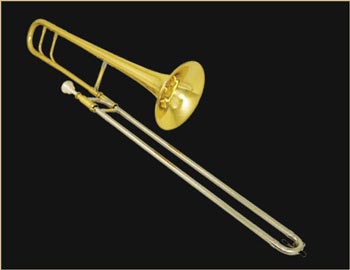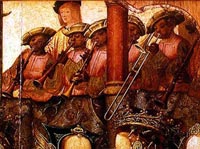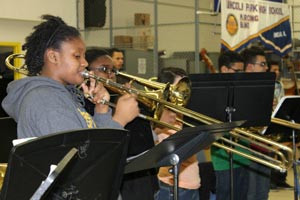

The trombone (German: Posaune, Spanish: trombon) is a musical instrument in the brass family. Like all brass instruments, sound is produced when the player's vibrating lips (embouchure) cause the air column inside the instrument to vibrate. Nearly all trombones have a telescoping slide mechanism that varies the length of the instrument to change the pitch. Instead of a slide, the valve trombone has three valves like those on a trumpet.

The word trombone derives from Italian tromba (trumpet) and -one (a suffix meaning "large"), so the name means "large trumpet". The trombone has a predominantly cylindrical bore like its valved counterpart the baritone horn and in contrast to its conical valved counterparts, the euphonium and the orchestral horn. The most frequently encountered trombones are the tenor trombone and bass trombone, while the E alto trombone has become less common as tenor technique has extended the upper range of that instrument. The most common variant, the tenor, is pitched in B?, an octave below the B? trumpet and an octave above the B? tuba. Trombone music, along with music for euphonium and tuba, is typically written in concert pitch, although exceptions do occur, notably in some brass band music where tenor trombone is presented as a B? transposing instrument. A person who plays the trombone is called a trombonist or trombone player.

When the "sackbut" returned to common use again in England in the 18th century, Italian music was so influential that rather than being known by its original name the instrument was known as the "trombone",[1] although other countries used the same name throughout the instrument's history, viz. Italian trombone and German Posaune. The 17th century trombone was built in slightly smaller dimensions than modern trombones, and had a bell that was more conical and less flared. The instrument was used extensively across Europe from its appearance in the 15th century to a fading out in most places across the mid-late 17th century. It was used in outdoor events, in concert and in liturgical settings. The groups varied from alta capella, wind ensembles, with voices, and in the first 'orchestra'-type ensembles in religious settings like St Mark's Basilica in Venice in the early 17th century. Famous composers writing for the trombone in this period include Giovanni Gabrieli and his uncle Andrea Gabrieli, Claudio Monteverdi and Heinrich Schutz. There are also some solo pieces written specifically for trombone in the early 17th century. During the later Baroque period, Johann Sebastian Bach and George Frideric Handel used the trombone on a few occasions; Bach used it in combination with the cornett to evoke the stile antico in some of his many cantatas and Handel used it in the Dead March from Saul, Samson, and Israel in Egypt, all of which were examples of a new oratorio style, popular during the early 18th century.

The use of the trombone in this period was mostly limited to Austria. The repertoire of trombone solo and chamber literature has its beginnings in Austria in the Classical Era where composers such as Leopold Mozart, Georg Christoph Wagenseil, Johann Albrechtsberger and Johann Ernst Eberlin were featuring the instrument, often in partnership with a voice. Joseph Haydn and Wolfgang Amadeus Mozart used the trombones in a number of their sacred works, including two extended duets with voice from Mozart, the best known being in the Tuba Mirum of his Requiem. Mozart also used trombones in several of his operas. The inspiration for many of these works is thought due to the virtuosic players in the courts at Vienna and Salzburg, including Thomas Gschladt and several members of a family named Christian. The trombone retained its traditional associations with the opera house and the Church during the 18th century and was usually employed in the usual alto/tenor/bass trio to support the lower voices of the chorus, though Viennese court orchestra Kapellmeister Johann Joseph Fux rejected an application from a bass trombonist in 1726 and restricted the use of trombones to alto and tenor only, which remained the case almost until the turn of the 19th century in Vienna, after which time a second tenor trombone was added when necessary. The construction of the trombone changed relatively little between the Baroque period and Classical period with the most obvious feature being the slightly more flared bell than was previously the custom. The first use of the trombone in a symphony was in 1807 in the Symphony in E by the Swedish composer Joachim Nicolas Eggert 1, although the composer usually credited with its introduction into the symphony orchestra was Ludwig van Beethoven, who used it in the last movement of his Symphony No. 5 in C minor (1808). Beethoven also used trombones in his Symphony No. 6 in F major ("Pastoral") and Symphony No. 9 ("Choral").

Despite the public's waning interest in classical, then jazz music, the trombone has remained a relevant instrument, though not always a prominent one. Nearly all flavors of jazz have used one or more trombones throughout the century. Originating in the Caribbean, salsa and ska music almost always incorporates a horn section including trombones. Rock bands with horn sections are relatively less common, but make for a distinctive sound in groups such as Chicago; Blood, Sweat & Tears; and Tower of Power. In the 1970s and 1980s, groups in the New Orleans brass band tradition began adding elements of funk, hip hop, and bop to their repertoires, but kept the instrumentation of sousaphone, trombones, and trumpets.